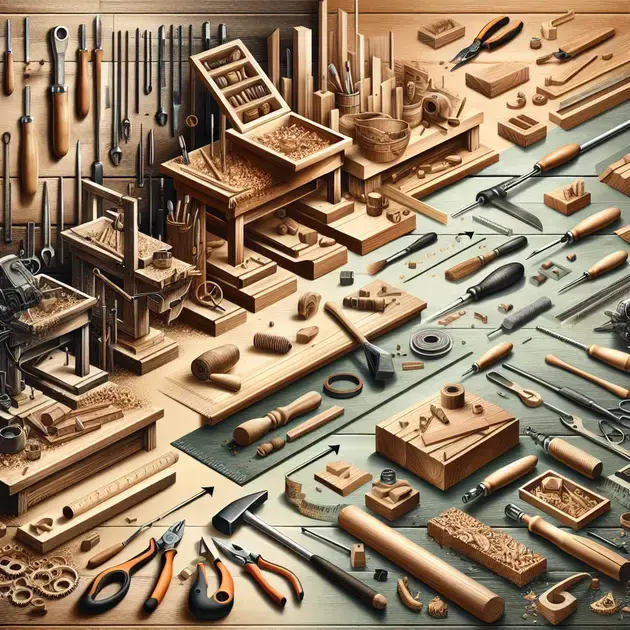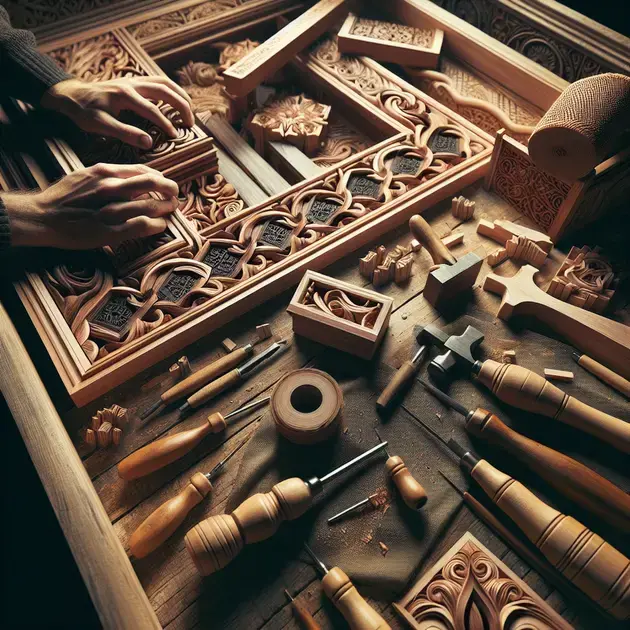Mastering the Art of Woodworking is a timeless skill that continues to gain popularity in today’s modern world. With the rise of DIY culture and the emphasis on sustainability, more and more people are turning to woodworking as a way to express their creativity and create unique, handcrafted pieces.
Whether you are a novice looking to learn the basics or an experienced woodworker seeking to enhance your skills, this blog post will provide valuable insights and tips to help you on your journey to mastering the art of woodworking. From selecting the right tools to mastering different techniques, we’ve got you covered!

Tips for Starting Your Woodworking Journey
Starting your woodworking journey can be an exciting and rewarding experience. Whether you’re a beginner or have some experience, these tips will help you get started on the right foot.
1. Research and Education
Before diving into woodworking, take some time to research and educate yourself on the basics. Websites like Wood Magazine (www.woodmagazine.com) and Popular Woodworking (www.popularwoodworking.com) offer a wealth of information on woodworking techniques, tools, and projects.
Consider taking online courses on platforms like Skillshare or Udemy to learn from experienced woodworkers. These courses can provide valuable insights and guidance for beginners.
2. Start with Simple Projects
When starting your woodworking journey, it’s important to begin with simple projects to build your skills and confidence. Websites like Ana White (www.anawhite.com) and Woodworking for Mere Mortals (www.woodworkingformeremortals.com) offer free plans for beginner-friendly projects.
Choose projects that match your skill level and gradually work your way up to more complex pieces. This approach will help you develop your woodworking skills effectively.
3. Invest in Quality Tools
Having the right tools is essential for a woodworking journey. Invest in quality tools from reputable brands like Festool, DeWalt, and Bosch. Websites like Woodcraft (www.woodcraft.com) and Rockler (www.rockler.com) offer a wide range of woodworking tools and supplies.
Start with basic tools like a saw, chisel, hammer, and measuring tape. As you progress, you can add more specialized tools to your collection. Quality tools will not only make your work easier but also ensure better results.
Essential Tools Every Woodworker Needs
As a woodworker, having the right tools is crucial for completing projects effectively and efficiently. Here are some essential tools that every woodworker should have in their toolkit.
1. Circular Saw
A circular saw is a versatile tool that can be used for a variety of cutting tasks in woodworking. Brands like Makita and Skil offer reliable circular saws that are suitable for beginners and experienced woodworkers alike.
When using a circular saw, always wear appropriate safety gear like goggles and gloves. Practice cutting on scrap wood before tackling your project to ensure accuracy.
2. Clamps
Clamps are essential for holding pieces of wood together securely during assembly. Brands like Bessey and Jorgensen offer a range of clamps in different sizes and styles to suit various woodworking needs.
Invest in a few different types of clamps, such as bar clamps, pipe clamps, and spring clamps, to handle different woodworking tasks effectively.
3. Random Orbital Sander
A random orbital sander is a must-have tool for smoothing out rough surfaces and preparing wood for finishing. Brands like Bosch and DEWALT offer quality orbital sanders that provide efficient sanding results.
When using a random orbital sander, always work in the direction of the wood grain to avoid scratches. Start with a lower grit sandpaper and gradually move to higher grits for a smooth finish.
Mastering Advanced Woodworking Techniques
Once you have honed your basic woodworking skills, it’s time to progress to advanced techniques that will take your woodworking projects to the next level. Here are some tips to help you master advanced woodworking techniques.
1. Dovetail Joints
Dovetail joints are a classic woodworking technique that adds strength and visual appeal to joints. Websites like Fine Woodworking (www.finewoodworking.com) offer detailed tutorials on how to create dovetail joints using hand tools or a router jig.
Practice creating dovetail joints on scrap wood before incorporating them into your projects. With patience and practice, you can master this advanced joinery technique.
2. Veneering
Veneering is a technique where thin slices of wood are glued onto a substrate to create decorative patterns or durable surfaces. Websites like The Wood Database (www.wood-database.com) provide information on different veneering techniques and wood species suitable for veneering.
Invest in a good veneer saw and adhesive for successful veneering projects. Experiment with different veneer patterns and combinations to enhance your woodworking skills.
3. Turning
Woodturning is a specialized woodworking technique that involves shaping wood on a lathe to create intricate designs and functional pieces like bowls and spindles. Platforms like Woodturning Online (www.woodturningonline.com) offer tutorials and resources for woodturners of all skill levels.
Start with simple turning projects like pens and bottle stoppers to familiarize yourself with the lathe and tools. As you gain confidence, you can explore more complex turning techniques and projects.

**Achieving Precision in Your Woodworking Projects**
1. Understanding the Importance of Precision
In woodworking, precision is crucial to achieving high-quality results. Whether you are crafting furniture, cabinetry, or decorative items, the accuracy of your measurements and cuts can make a significant difference in the final product. To ensure precision in your woodworking projects, it is essential to pay attention to details and follow best practices.
Step-by-step guide:
1. Start by using high-quality measuring tools such as a tape measure, combination square, and calipers to accurately measure and mark your wood.
2. Double-check your measurements before making any cuts to avoid costly mistakes.
3. Invest in sharp cutting tools and maintain them regularly to ensure clean and precise cuts.
4. Practice proper technique when using power tools to maintain control and accuracy.
5. Test-fit your pieces before final assembly to catch any potential errors and make adjustments as needed.
2. Techniques for Enhancing Precision
There are several techniques you can use to enhance the precision of your woodworking projects. One effective method is the use of jigs and fixtures to guide your cuts and ensure consistency. Additionally, incorporating hand tools for fine detail work can help you achieve a higher level of precision in intricate designs.
Step-by-step guide:
1. Create custom jigs for specific cuts or joinery tasks to streamline your workflow and maintain consistency across multiple pieces.
2. Practice hand-cut joinery techniques such as dovetails and mortise-and-tenon joints to hone your precision skills and create visually appealing connections.
3. Use layout tools like marking gauges and marking knives to establish accurate reference points for your cuts and measurements.
4. Incorporate sanding techniques to achieve smooth surfaces and tight-fitting joints for a professional finish.
5. Experiment with different wood species and grain directions to understand how they affect the precision of your cuts and overall project outcome.
**Exploring Creative Design Elements in Woodworking Art**
1. Incorporating Unique Design Elements
Woodworking art offers endless opportunities for creativity and expression. By incorporating unique design elements into your projects, you can elevate the aesthetic appeal and showcase your craftsmanship. Whether it’s experimenting with different wood textures, incorporating mixed media, or exploring unconventional shapes, creative design elements can set your woodworking art apart.
Step-by-step guide:
1. Research different design styles and techniques to draw inspiration for your woodworking projects.
2. Experiment with combining various materials such as metal accents, resin inlays, or even recycled elements to add depth and interest to your designs.
3. Explore alternative joinery methods and sculptural elements to create dynamic and visually striking pieces.
4. Consider incorporating personalized touches such as custom engravings, intricate carvings, or unique finishes to make your woodworking art truly one-of-a-kind.
5. Collaborate with other artisans or designers to gain new perspectives and push the boundaries of traditional woodworking art.
Conclusion
Ensuring precision in woodworking projects is imperative for achieving exceptional results. By understanding the significance of accuracy in measurements and cuts, woodworkers can elevate the quality of their creations, be it furniture, cabinetry, or decorative items. Attention to detail and adherence to best practices are key components in the pursuit of precision.
Utilizing high-quality measuring tools like tape measures, combination squares, and calipers, along with double-checking measurements and maintaining sharp cutting tools, are crucial steps towards precision. Practicing proper techniques with power tools and test-fitting pieces before final assembly help in identifying and rectifying errors, ensuring a flawless outcome.
Enhancing Precision Techniques
Enhancing precision further involves utilizing jigs and fixtures to guide cuts and maintain uniformity, as well as incorporating hand tools for intricate detail work. Creating custom jigs, mastering hand-cut joinery techniques like dovetails, and using layout tools for accurate reference points contribute to the pursuit of precision. Additionally, experimenting with various wood species, grain directions, and sanding techniques offer insights into how these factors influence project outcomes.
When exploring creative design elements in woodworking art, the possibilities are endless. Incorporating unique elements such as different textures, mixed media, and unconventional shapes can add artistic flair to projects, showcasing craftsmanship. By researching design styles, experimenting with diverse materials, exploring alternative joinery methods, and adding personalized touches like engravings or carvings, woodworkers can create truly distinctive pieces of art. Collaboration with other artisans can also provide fresh perspectives and help push the boundaries of traditional woodworking art, fostering innovation and creativity in the craft.